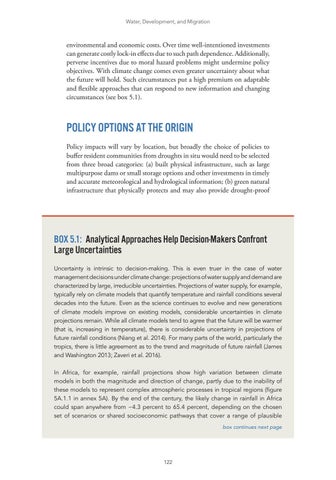Water, Development, and Migration
environmental and economic costs. Over time well-intentioned investments can generate costly lock-in effects due to such path dependence. Additionally, perverse incentives due to moral hazard problems might undermine policy objectives. With climate change comes even greater uncertainty about what the future will hold. Such circumstances put a high premium on adaptable and flexible approaches that can respond to new information and changing circumstances (see box 5.1).
POLICY OPTIONS AT THE ORIGIN Policy impacts will vary by location, but broadly the choice of policies to buffer resident communities from droughts in situ would need to be selected from three broad categories: (a) built physical infrastructure, such as large multipurpose dams or small storage options and other investments in timely and accurate meteorological and hydrological information; (b) green natural infrastructure that physically protects and may also provide drought-proof
BOX 5.1: Analytical Approaches Help Decision-Makers Confront Large Uncertainties Uncertainty is intrinsic to decision-making. This is even truer in the case of water management decisions under climate change: projections of water supply and demand are characterized by large, irreducible uncertainties. Projections of water supply, for example, typically rely on climate models that quantify temperature and rainfall conditions several decades into the future. Even as the science continues to evolve and new generations of climate models improve on existing models, considerable uncertainties in climate projections remain. While all climate models tend to agree that the future will be warmer (that is, increasing in temperature), there is considerable uncertainty in projections of future rainfall conditions (Niang et al. 2014). For many parts of the world, particularly the tropics, there is little agreement as to the trend and magnitude of future rainfall (James and Washington 2013; Zaveri et al. 2016). In Africa, for example, rainfall projections show high variation between climate models in both the magnitude and direction of change, partly due to the inability of these models to represent complex atmospheric processes in tropical regions (figure 5A.1.1 in annex 5A). By the end of the century, the likely change in rainfall in Africa could span anywhere from −4.3 percent to 65.4 percent, depending on the chosen set of scenarios or shared socioeconomic pathways that cover a range of plausible box continues next page
122



